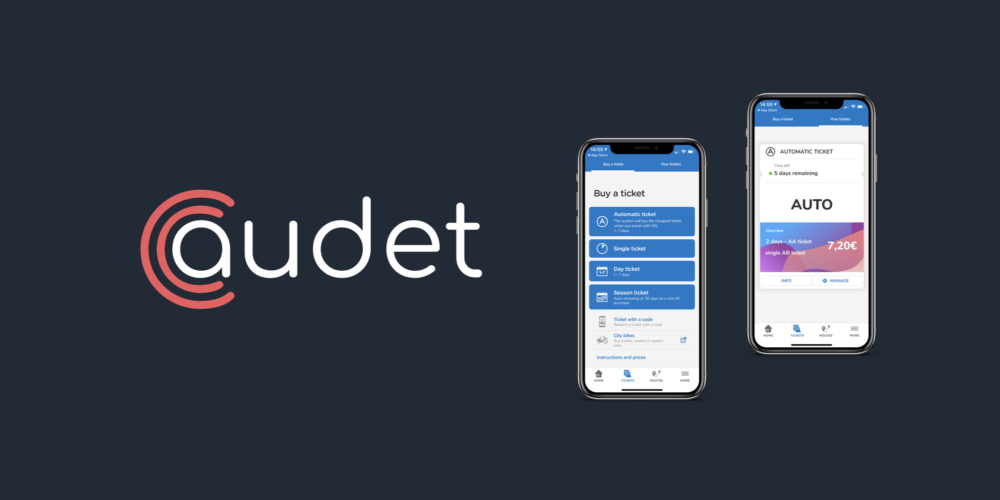Audet is the automatic detection system for easy and safe transportation.
The project was developed during the EIT Digital Summer School 2020 “Design Thinking & Scaling Services for Cities” in Helsinki.
HSL, the public transport company of Helsinki, provided us with this question: how can we bring back the feeling of safety (tourists’ perspective) while travelling with public transportation during and after COVID 19?
In our international team, we were asked to use design thinking methodologies to analyse the current situation and propose an innovative and feasible solution.
The context
Finland is characterised by having one of the most efficient transport systems and satisfied users of public transport in Europe (according to the international BEST survey). Nevertheless, COVID pandemic consequences severely affected the country. Passengers in June 2020 made up only 22 per cent of the number of passengers in June 2019. Moreover, no passengers of foreign cruise ships arrived in Finland during the entire month. Consequently, public transport ticket sales have dropped dramatically.
According to WHO, public transport systems can be considered a high-risk environment due to:
- a high number of people in a confined space with limited ventilation;
- no access control to identify potentially sick persons;
- a variety of common surfaces to touch (ticket machines, handrails, doorknobs, etc.).
Therefore, our challenge is to identify solutions on how we can bring back the feeling of safety while travelling with public transportation during and after COVID 19 (under tourists perspective)
HSL pain points
- Providing information in different languages: HSL aims to spread information to users effectively, but tourists may have language barriers.
- Rapidly changing information: regarding COVID regulation (distancing measures, etc.).
- Travellers without a ticket.
- The decreasing number of users: both national and international visitors declined considerably during the COVID pandemic expansion.
- Many entry-points into the city: as HSL system is composed of many transport modes (tram, bus, metro, etc.), it is not easy to apply the same measures to all vehicles. This can create confusion in the customers.
Tourists pain points
- Lost in translation: Tourists may face language barriers when using public transport. Consequently, having difficulties understanding important indications and getting lost and confused.
- Understanding the new ticket system: ticketing system differs a lot depending on the city or even transport mode. Users aim to get the cheapest ticket option when possible.
- Afraid of getting infected: Users want minimum contact and want to avoid crowds in public places.
Proposed solution: Audet
Audet is an AUtomatic DEtection system for public Transport. We offer a technological solution that enables easy and safe transportation.
Everything started with the following question. “How might we provide a touchless travel experience so that transportation companies can recover the feeling of trust and safety even from users scared of getting infected?”
We soon realised that a touchless experience means relying on devices that the end-user already has. However, a mobile application is not enough. As we aim to create value for our customers and provide a straightforward experience for travellers, we need to reduce the requests of user’s actions and at the same time record some data.
Automatic vehicle detection allows us always to provide correct information and take the right action accordingly to the identified vehicle. The idea of a BIBO (Be In – Be Out) system is not new in the market. What is new is the exploitation of that paradigm not only for a specific task but for an entirely redesigned travel experience. Moreover – especially considering the COVID19 crisis – this solution provides a way to give travellers always the correct information on safety rules, avoiding language barriers, and safer ways to take public vehicles. The transportation company will also take advantage of the data collected from the system. Monitoring the number of people present in the vehicle could allow efficient cleansing management or future development of the system.
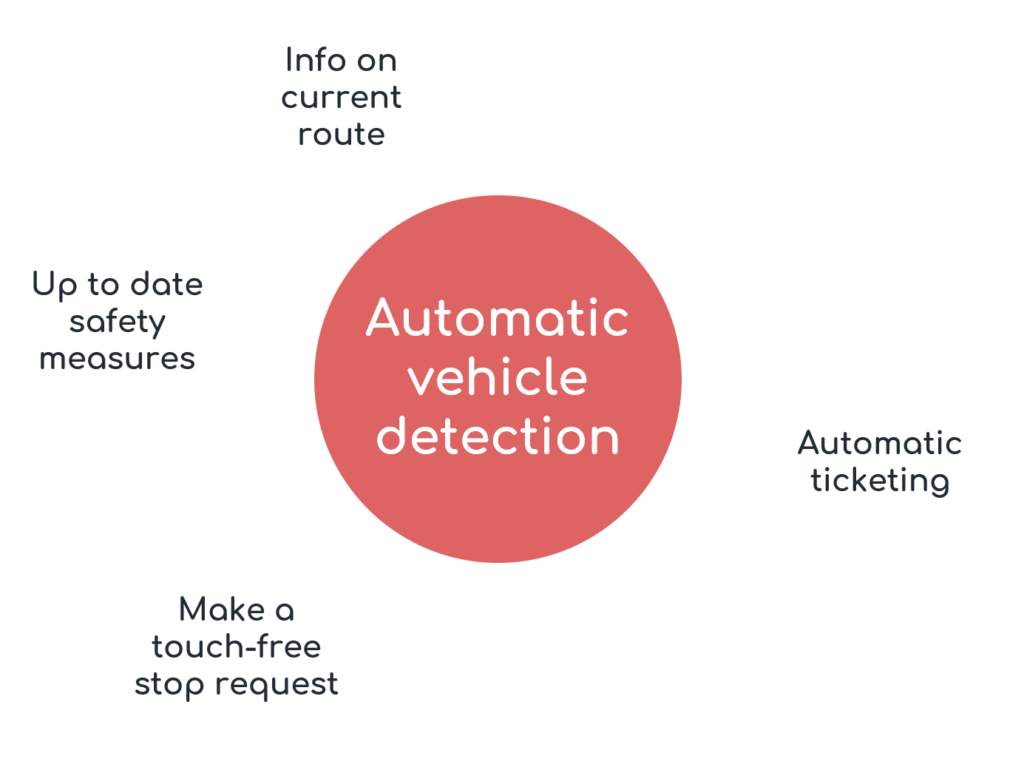
Features for travellers
The four main features visible from the end-user are:
- Info on the current route: it is possible to see the next stops and the estimated time of arrival. If there are any changes in the path, users can see the details.
- Up-to-date safety measures: all the safety measures required for the specific vehicle are shown clearly. Graphical images are used to overcome language barriers.
- Touch-free stop request. Requesting the stop of the vehicle is as easy as tapping an icon on the phone screen. And if the user demands the stop by error, it is possible to cancel the request.
- Automatic ticketing: the vehicle detection is used to buy the tickets over the day progressively. A fair ticketing approach is used; if it is more convenient for the traveller to have a two-days card, the conversion happens automatically. This ticketing system is suitable for travellers or people that use public transport rarely as it is not intended to substitute the long-term travel plans.
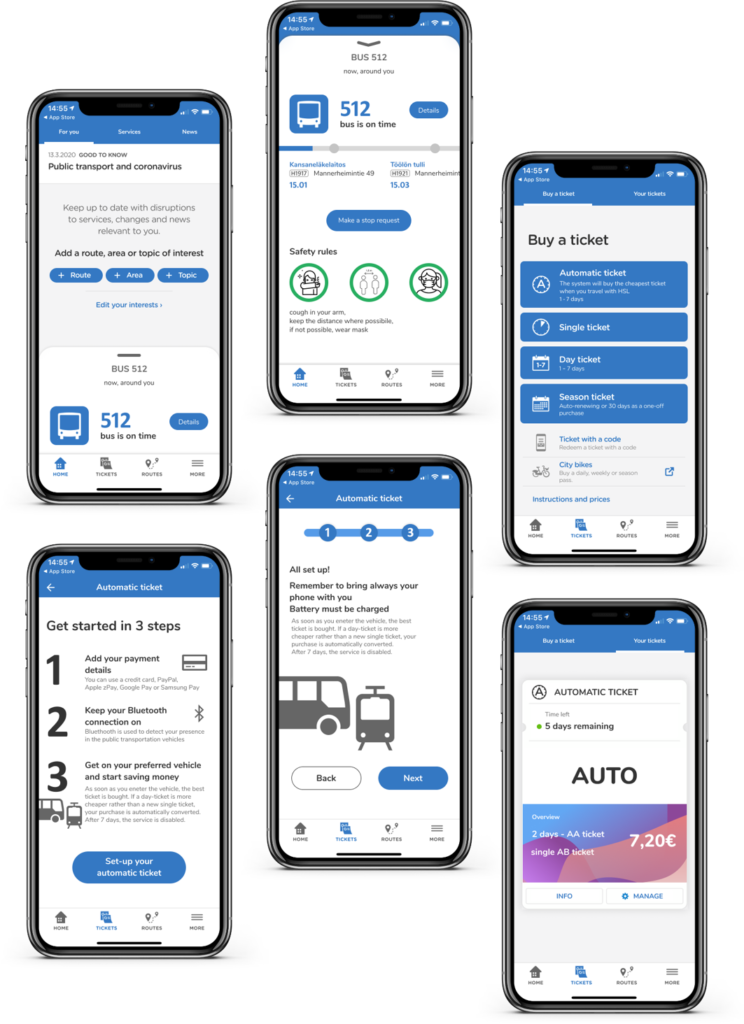
Technology perspective
The enabling technology is cheap and commonly used in other contexts. audet relies on BLE beacons installed in the vehicles and a mobile application – the PT company one. Once the smartphone detects the beacon, notifies the user of the availability of both information and actions. If the traveller has already enabled the automatic ticketing service, the phone will automatically start the “trip”. Algorithms ensure that no fake trips are charged. The communication to the servers begin from the phone, and it is possible only if the PT app is installed. This ensures the privacy of the users. In fact, the system is not detecting the phones, but the phones are detecting the system and act only if the app is installed and permissions are granted.
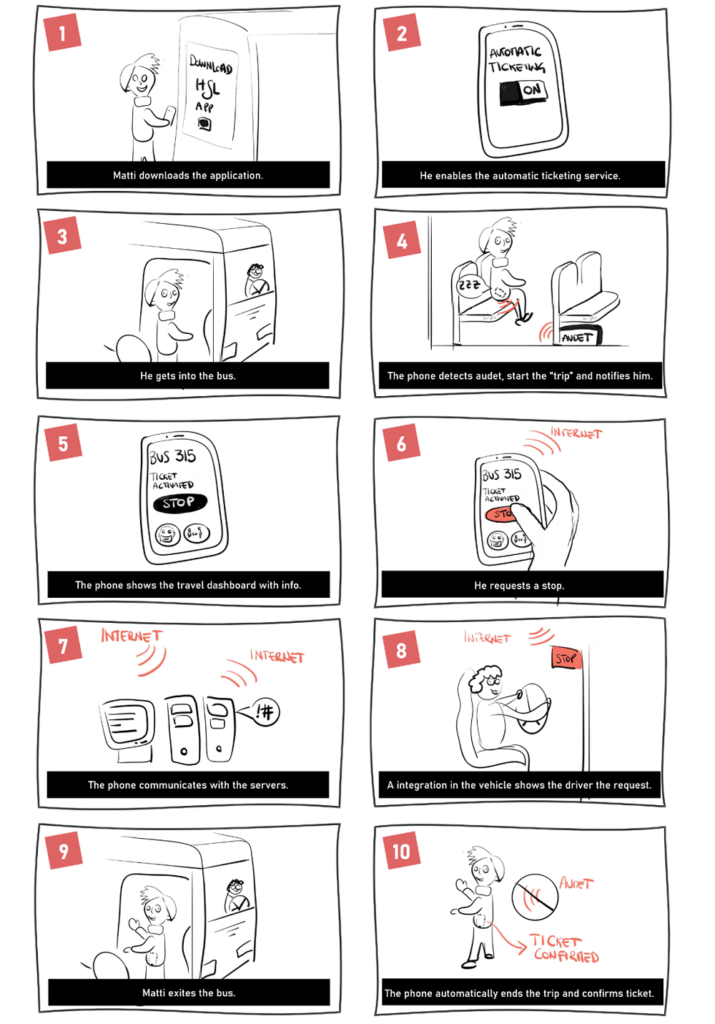
Roadmap
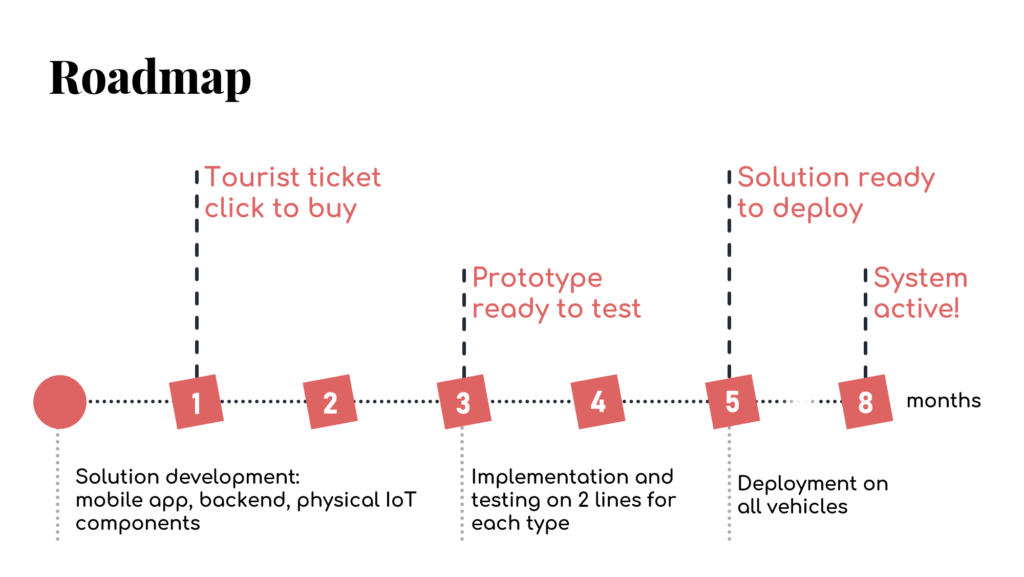
Business model
Audet aims to start as a company which sells both the technological devices and the software to enable the automatic detection system and the corresponding features. A strong network of partners is crucial as we aim to rapidly increase the number of cities in which our service creates value for the transportation companies.
Building a personal customer relationship allows us to deliver the solution using different approaches. First, there is the need for co-designing the integration between audet system and the one currently present on the vehicles. Then, the transportation corporation can choose to host the backend on their servers or pay a fixed subscription using a Software As A Service model.
Whatever is the choice, the companies are going to subscribe to a customer service and maintenance plan. The modularity of the solution allows them to choose between different features they want/need on their systems. E.g., the vehicle stop request requires a deeper integration with the vehicles, and some companies may want to wait before adding this feature.
The automatic ticketing service is the one on which we are putting more focus. In fact, getting a big network of companies using our system could allow a later creation of a platform to sell automatic tickets, manage onboard actions (bus stop request) and show travel information for different cities. In the first phase of our business, the main costs are due to the hardware and software R&D, the staff needed for adaptation, installation and maintenance of our products and the marketing activities. If there is the need to host the computation, we are going to rely on third-party online PaaS/IaaS that are provided with no upfront costs and can be scaled easily to match the requests. Once the algorithms and the hardware are developed, the costs are way lower.
The team
Enrique Nieto
Lilly A. Helmersen
Luca Zorzenon
Mireia Dilmé
Rajat Sahore
The summer school
The Summer School was a two-week event organised by the EIT Digital Master School and Aalto University Developing Entrepreneurship, where students from different masters/majors worked on a business development project.
The topic of the activity was “Design Thinking and Scaling Services for cities”. There were ample opportunities to interact with other stakeholders, such as companies, researchers, business consultants, market research experts, and users.
During this program, we improved our skills. At the end of the program, we
- had a wide-ranging understanding of urban planning and development,
- understood how to apply Design Thinking methodology in real business cases,
- had capabilities to lead a process from idea to a prosperous business,
- knew how to use different tools and frameworks for scaling up the innovation.
